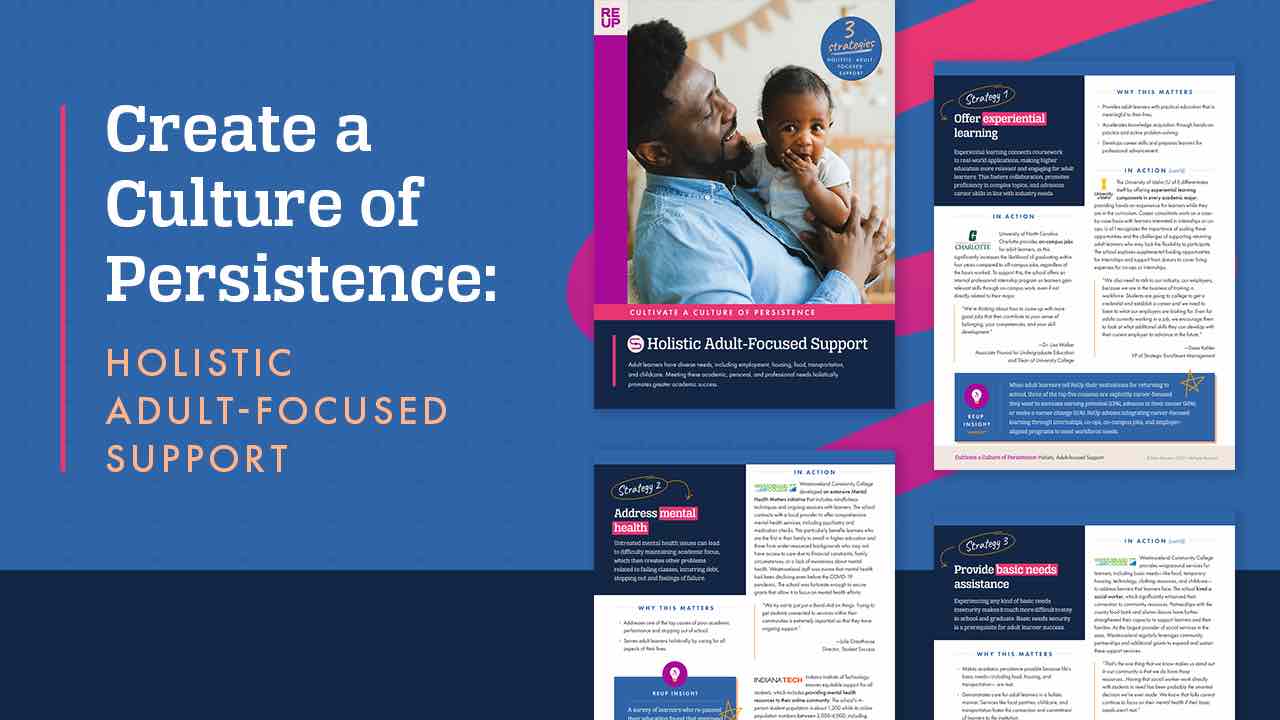
Rethinking the status quo on the transfer process to put students at the center

Community colleges and four-year institutions can play a role in advancing equity for transfer students. Here are the most common challenges facing transfer students that we’ve seen at ReUp, and what can be done to support them in meeting their educational goals.
Adult learners face many barriers when it comes to earning life-changing credentials that can lift up their families, communities, regions, and states. Transferring from a community college to a BA-level institution shouldn’t be one of them.
According to the NSCRC, the proportion of students transferring from community colleges to bachelor’s degree-granting universities fell by about 10% over the past two years. The decline is even bigger for Black students (14%) and men (12%).
When community colleges and bachelor’s-level institutions don’t work together, enrollment strategies focus on filling empty seats instead of creating career development pipelines for underserved communities. This only reinforces structural inequity and ultimately undermines higher ed’s goals of working towards greater equity.
How can community colleges and four-year institutions do better? In a word: support. At ReUp, we understand the barriers that adult learners face in attaining their educational goals because we’ve supported hundreds of thousands of adult learners. Below are our best practices for setting transfer students up for success, ensuring that they can get to and through their educational journey.
How institutions can provide successful transfers
Creating lasting, sustainable student support through the transfer process can’t happen without buy-in from both community college and bachelor-level institutions, who need to work together to ensure a seamless transfer process that addresses the whole student.
As many higher-ed student advisors know, finances can create major barriers for students to stay committed to their education goals–especially at the community college level. According to ReUp’s own data on adult learners, financial resources are the most common reason for stopping out of college (24%). For many students, limited finances and personal commitments are deeply intertwined, creating an outsized impact on students’ prospects of transferring and/or earning a credential.
What is at stake if students cannot navigate the transfer process by finding an educational pathway that’s right for them? They either won’t be able to matriculate, or they won’t be able to afford the additional credits they need to graduate once transferred. Equity in education will in turn become even more unattainable.
ReUp’s best practices for advising transfers
ReUp has learned from adult learners through its Success Coaches that many students, especially first generation, are unaware of the hidden obstacles of matriculation. The following table explains typical standards practice when it comes to advising and guiding students through to matriculation. A more student-centric approach can be found on the far-right column:
To receive support and guidance, students must make time with advisors during typical business hours that are difficult to schedule.
Working students can easily schedule meetings, or walk-in to speak with advisors and other staff, with availability on evenings and weekends, both online and in-person.
Students conduct self-directed research into academic and career pathways, relying on websites and second-hand information from family and other acquaintances.
Advisors preemptively check in with students to understand engagement in current courses or areas of studies, asking guiding questions about their goals, motivations and aspirations.
Students are expected to develop relationships with instructors and/or potential employers to gain insights into their field of study.
Institutions provide events, online networks, and other programs to connect students to alumni, faculty, and employers in fields that interest them.
First term or year spent on general educational requirements that may not provide clarity on students’ ultimate field of interest.
Students enroll in at least one course that excites and motivates them that is not a part of their standard general education requirements.
Students must take initiative to work with advisors, knowing exactly what kind of help they need and what kinds of tools that advisors and support staff can offer.
Advisors and staff hold regular check-ins, building relationships and helping students develop educational goals, as well as a system that helps them stay on track.
Whether you are an advisor at a community college or Bachelor’s level college, here are some of our key recommendations for helping students navigate the transfer process:
- Advise students about their degree plans early. For community college advisors, in particular, be proactive by helping students identify goals in their first 1-2 advisement sessions—don’t wait until they are about to transfer to make sure credits are aligned.
- Understand root problems of the transition process. Look at the top schools your students are matriculating to/from—are there frequent instances where they may not be aware of, or confused by, enrollment requirements? This will give you an indication as to who you should be working with.
- Reach out to institutions and collaborate. Build relationships and partnerships with the schools that your students are attending—these partners can become instrumental in filling in the gaps in student data and developing cohesive, joint strategies that create degree pathways.
- Centralize efforts. Maintain a level of transparency on how students are being advised and create a single source of truth regarding credit applicability, enabling institutions to disaggregate the same sets of data. For dual admissions agreements to work for students, learning assessments and credit by examination should be easy for both them and for advisors to understand.
- Provide more options to students. Often, students do not know what their educational goals are until they’ve had an understanding of what academic paths they can choose from. They also need to know which credits may not transfer, and what the costs might be should they need to take more classes after matriculating. This is the time when advisors should explore the possibility of reverse articulation agreements, a reverse transfer process, course substitution policies, and other options to make sure students are clear on what the process looks like.
When institutions partner and collaborate on a system that places students at the center, everyone benefits: students enjoy a stronger sense of support and belonging, support teams feel more alignment with the equity goals of their institutions, and institution partners gain rich insights that will benefit all students and stakeholders in the future.
As Scaling Partners put it in their Transfer and Applicability Call to Action:
“Repeatedly, students are asked to prove what they have learned even when they come with transcripts documenting successful course completion and/or nontraditional coursework. That
practice is no longer acceptable. The time has come for institutions to design systems to apply maximum credit in transfer and to lower artificial barriers to the creation of seamless pathways.”
Cherish Brunet is ReUp’s Manager of Learner Services. Through her work with nearly 100 universities, as well as national transfer student organizations, she reviews processes and policies, explores barrier remediation options, and listens to thousands of adult learners, influencing processes and striving to impact equity for transfer students across the country.
Let’s start the conversation
Schedule a call with a ReUp team member to learn more about what a ReUp partnership could do for your institution.

